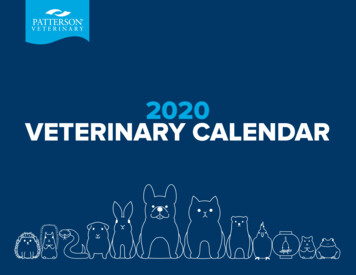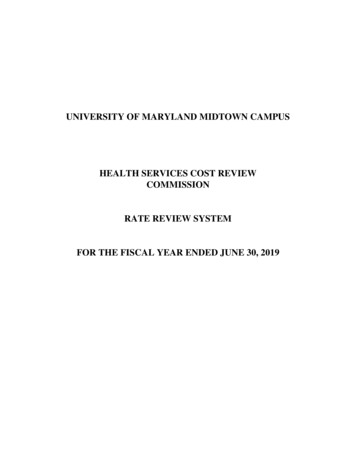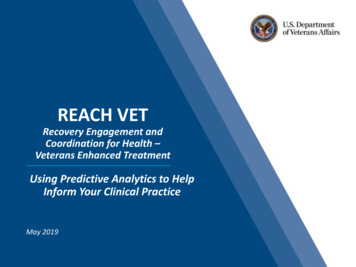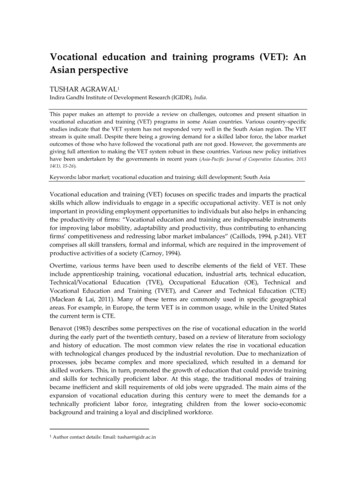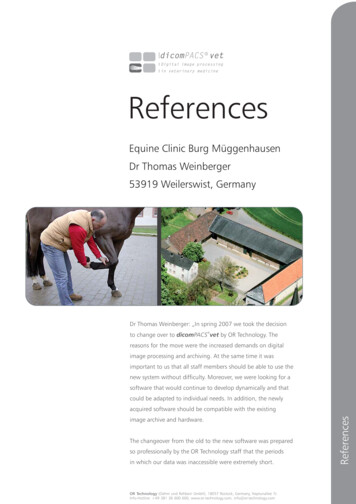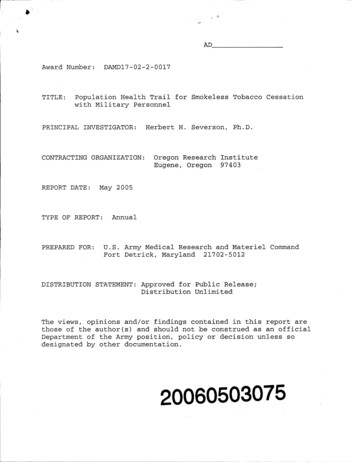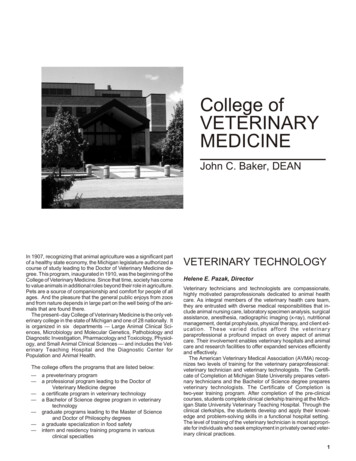
Transcription
College ofVETERINARYMEDICINEJohn C. Baker, DEANIn 1907, recognizing that animal agriculture was a significant partof a healthy state economy, the Michigan legislature authorized acourse of study leading to the Doctor of Veterinary Medicine degree. This program, inaugurated in 1910, was the beginning of theCollege of Veterinary Medicine. Since that time, society has cometo value animals in additional roles beyond their role in agriculture.Pets are a source of companionship and comfort for people of allages. And the pleasure that the general public enjoys from zoosand from nature depends in large part on the well being of the animals that are found there.The present–day College of Veterinary Medicine is the only veterinary college in the state of Michigan and one of 28 nationally. Itis organized in six departments — Large Animal Clinical Sciences, Microbiology and Molecular Genetics, Pathobiology andDiagnostic Investigation, Pharmacology and Toxicology, Physiology, and Small Animal Clinical Sciences — and includes the Veter i nary Teach ing Hos pi tal and the Di ag nos tic Cen ter forPopulation and Animal Health.The college offers the programs that are listed below:———————a preveterinary programa professional program leading to the Doctor ofVeterinary Medicine degreea certificate program in veterinary technologya Bachelor of Science degree program in veterinarytechnologygraduate programs leading to the Master of Scienceand Doctor of Philosophy degreesa graduate specialization in food safetyintern and residency training programs in variousclinical specialtiesVETERINARY TECHNOLOGYHelene E. Pazak, DirectorVeterinary technicians and technologists are compassionate,highly motivated paraprofessionals dedicated to animal healthcare. As integral members of the veterinary health care team,they are entrusted with diverse medical responsibilities that include animal nursing care, laboratory specimen analysis, surgicalassistance, anesthesia, radiographic imaging (x-ray), nutritionalmanagement, dental prophylaxis, physical therapy, and client edu ca tion. T hese var ied du ties af ford the vet er i nar yparaprofessional a profound impact on every aspect of animalcare. Their involvement enables veterinary hospitals and animalcare and research facilities to offer expanded services efficientlyand effectively.The American Veterinary Medical Association (AVMA) recognizes two levels of training for the veterinary paraprofessional:veterinary technician and veterinary technologists. The Certificate of Completion at Michigan State University prepares veterinary technicians and the Bachelor of Science degree preparesveterinary technologists. The Certif icate of Completion istwo-year training program. After completion of the pre-clinicalcourses, students complete clinical clerkship training at the Michigan State University Veterinary Teaching Hospital. Through theclinical clerkships, the students develop and apply their knowledge and problem-solving skills in a functional hospital setting.The level of training of the veterinary technician is most appropriate for individuals who seek employment in privately owned veterinary clinical practices.1
VETERINARY MEDICINEVeterinary TechnologyVeterinary technologists require four years of academic training. In addition to the core curriculum of the Certificate of Completion, the students complete the general education requirementsof Michigan State University and elective courses. The electivecourses allow the students to focus on potential career pathswithin the veterinary profession such as production animal medicine, equine and companion animal medicine, pathology, biomedical research, and practice management. Their training offersexposure to clinical specialty areas such as emergency medicine,cardiology, ophthalmology, equine anesthesia, and necropsy.The level of training of the veterinary technologist is linked withemployment in research facilities, vivaria, industry, educationalinstitutions, pharmaceutical companies, and large-group orspeciality practices.The state of Michigan requires that any person practicing as aveterinary technician/technologist must be licensed and registered with the state. Regulation of veterinary technicians/technologists is the responsibility of the Veterinary Board of Examiners inthe Michigan Department of Licensing and Regulation. Thecredentialing examination is only available to qualified graduatesof accredited training programs. The Veterinary Technology Program is accredited by the American Veterinary Medical Association (AVMA) and graduates of the Certificate of Completion orBachelor of Science in Veterinary Technology are eligible to takethe National and State Board Examinations for licensure.Enrollment in the Veterinary Technology Program’s academiccertificate and degree options is limited. Students are admittedfor fall semester only. Applications for admission are acceptedthrough January 15th of the year that admission is sought. For additional information, contact the Veterinary Technology Program,Veterinary Medical Center-South Building, 784 Wilson Road,Room F-101, Michigan State University, East Lansing, MI48824-1316 or visit http://cvm.msu.edu.The Certificate of Completion articulates with an Associate inApplied Sciences degree from Lansing Community College. Forspecific degree requirements for the Associate in Applied Science, contact Lansing Community College at http://www.lcc.edu.Bachelor of ScienceAdmissionThe number of students who can be admitted to the Bachelor ofScience degree program in veterinary technology is limited. Allpersons who are interested in applying for admission to the bachelor's degree program in veterinary technology must request aspecial application form and detailed information regarding admission requirements and procedures from the Veterinary Technology Program, Veterinary Medical Center-South Building, 784Wilson Road, Room F-101, Michigan State University, East Lansing, MI 48824-1316.Applications for admission to the bachelor's degree program inveterinary technology are accepted through January 15th of theyear that admission is sought.Students who are enrolled in colleges and universities otherthan Michigan State University should contact Michigan StateUniversity's Office of Admissions and the College of VeterinaryMedicine regarding admission to the bachelor's degree programin veterinary technology as transfer students.Minimal criteria for admission to the Bachelor of Science degree program in Veterinary Technology are:1. Completion of at least 28 credits of the University graduationrequirements or transfer equivalents with a cumulativegrade-point average of 2.5 or higher including:a. Mathematics 103 or 110 or 116 or 124 or 132 or 152H.b. Biological Science 161 and 171.c. Tier I writing course.2d.Additional credits selected from an Integrative Studiesin the Arts and Humanities course numbered below 211,an Integrative Studies in the Arts and Humanitiescourse numbered 211 or higher, an Integrative Studiesin the Social, Behavioral, and Economic Sciences200-level course, and an Integrative Studies in the Social, Behavioral, and Economic Sciences 300-levelcourse.The final selection of students to be admitted to the baccalaureate degree program in veterinary technology is based on the cumu la tive grade-point av er age of all courses taken, thegrade-point average calculated on all courses in mathematicsand the physical and biological sciences, and the grade-point average of the last 12 credits. The selection process also includessubmission of a personal statement, letters of recommendationand documentation of 80 hours of veterinary related experience.Students who complete the requirements for the Bachelor ofScience degree in Veterinary Technology will be qualified to takethe National and State Board Examinations for licensure as veterinary-technicians.Requirements for the Bachelor of Science Degreein Veterinary Technology1. The requirements for a bachelor's degree as specified in the Undergraduate Education section of the University catalog; 120 credits, including general elective credits,are required for the Bachelor of Science degree in Veterinary Technology.The completion of Mathematics 110 or 116 that is referenced in item 2. b. below mayalso be used to satisfy the University mathematics requirement.The University's Tier II writing requirement for the Veterinary Technology major ismet by completing the following courses: Veterinary Medicine 410, 411, 412, 413, and415. Those courses are referenced in items 2. a. and 2. d. below.Students who are enrolled in the Bachelor of Science degree in Veterinary Technology may complete the alternative track in Integrative Studies in Biological and PhysicalSciences that consists of the following courses: Biological Sciences 161, 162, 171,and 172; and Chemistry 141. The completion of Biological Science 171 satisfies thelaboratory requirement. Biological Science 162 and 172 and Chemistry 141 may becounted toward both the alternative track and the requirements for the major referenced in item 2. below.CREDITS2. The following requirements for the major: . . . . . . . . . . . . . . . . . . . . . . .a.All of the following courses (73 credits):BS161 Cell and Molecular Biology . . . . . . . . . . . . . . . . . . 3BS162 Organismal and Population Biology . . . . . . . . . . . 3BS171 Cell and Molecular Biology Laboratory . . . . . . . . . 2BS172 Organismal and Population Biology Laboratory . . 2CEM 141 General Chemistry . . . . . . . . . . . . . . . . . . . . . . . . 4VM110 Veterinary Medical Terminology . . . . . . . . . . . . . . 1VM120 Veterinary Comparative Nutrition . . . . . . . . . . . . . 2VM130 Comparative Anatomy for VeterinaryTechnicians . . . . . . . . . . . . . . . . . . . . . . . . . . . . 2VM140 Pharmacology for Veterinary Technicians . . . . . . 2VM150 Hospital Procedures and Communication. . . . . . . 2VM155 Veterinary Technology Careers andProfessional Development. . . . . . . . . . . . . . . . . 1VM160 Small Animal Nursing Skills . . . . . . . . . . . . . . . . . 3VM165 Large Animal and Laboratory AnimalNursing Care Techniques . . . . . . . . . . . . . . . . . 2VM170 Hematology and Immunology forVeterinary Technicians . . . . . . . . . . . . . . . . . . . 2VM175 Clinical Pathology Laboratory I forVeterinary Technicians . . . . . . . . . . . . . . . . . . . 1VM176 Clinical Pathology Laboratory II forVeterinary Technicians . . . . . . . . . . . . . . . . . . . 1VM205 Preventive Animal Health Care for VeterinaryTechnicians . . . . . . . . . . . . . . . . . . . . . . . . . . . . 3VM210 Surgical Nursing for Veterinary Technicians . . . . . 2VM215 Surgical Nursing and AnestheticManagement Laboratory . . . . . . . . . . . . . . . . . . 1VM245 Parasitology for Veterinary Technicians . . . . . . . . 2VM250 Veterinary Comparative Clinical Physiology . . . . . 5VM255 Small Animal Diseases and Management . . . . . . 3VM265 Dentistry Techniques for Veterinary Technicians . 1VM270 Advanced Skills Development for VeterinaryTechnicians . . . . . . . . . . . . . . . . . . . . . . . . . . . . 1VM275 Large Animal Diseases and Management . . . . . . 3VM295 Biomedical Research and RegulatoryIssues for Veterinary Technicians . . . . . . . . . . . 1VM303 Anesthesiology for Veterinary Technicians . . . . . . 2VM304 Radiology for Veterinary Technicians . . . . . . . . . . 2VM305 Hospital Practice Management forVeterinary Technicians . . . . . . . . . . . . . . . . . . . 2VM410 Veterinary Technology Clerkship inAnesthesiology . . . . . . . . . . . . . . . . . . . . . . . . . 3VM411 Veterinary Technology Clerkship in Radiology . . . 3103
VETERINARY MEDICINEProfessional Program in Veterinary MedicineVMb.c.d.412 Veterinary Technology Clerkship inCompanion Animal Medicine. . . . . . . . . . . . . . . 3VM413 Veterinary Technology Clerkship inCompanion Animal Surgery. . . . . . . . . . . . . . . . 3One of the following courses (5 credits):MTH 110 Finite Mathematics and Elements of CollegeAlgebra . . . . . . . . . . . . . . . . . . . . . . . . . . . . . . . 5MTH 116 College Algebra and Trigonometry . . . . . . . . . . . . 5At least 7 credits from the following courses approved by the student’s academic advisor:ABM 100 Decision-making in the Agri-Food System . . . . . . 3ABM 225 Commodity Marketing I . . . . . . . . . . . . . . . . . . . . . 3ACC 230 Survey of Accounting Concepts . . . . . . . . . . . . . . 3ANS 305 Applied Animal Behavior . . . . . . . . . . . . . . . . . . . . 3ANS 313 Principles of Animal Feeding and Nutrition . . . . . . 4ANS 314 Genetic Improvement of Domestic Animals . . . . . 4ANS 404 Advanced Animal Genetics . . . . . . . . . . . . . . . . . . 2ANS 407 Food and Animal Toxicology. . . . . . . . . . . . . . . . . 3ANS 413 Monogastric Animal Nutrition . . . . . . . . . . . . . . . . 3ANS 417 Topics in Toxicology . . . . . . . . . . . . . . . . . . . . . . . 1ANS 445 Equine Exercise Physiology . . . . . . . . . . . . . . . . . 4EPI390 Disease in Society: An Introduction toEpidemiology and Public Health . . . . . . . . . . . . 4PHM 350 Introductory Human Pharmacology. . . . . . . . . . . . 3VM285 Clinical Nutrition for Veterinary Technologists . . . 1VM310 Advanced Clinical Pathology Techniques . . . . . . . 1ZOL 313 Animal Behavior . . . . . . . . . . . . . . . . . . . . . . . . . . 3ZOL 341 Fundamentals of Genetics . . . . . . . . . . . . . . . . . . 4ZOL 369 Introduction to Zoo and Aquarium Science . . . . . . 3ZOL 402 Neurobiology . . . . . . . . . . . . . . . . . . . . . . . . . . . . . 3ZOL 408 Histology . . . . . . . . . . . . . . . . . . . . . . . . . . . . . . . . 4ZOL 413 Laboratory in Behavioral Neuroscience (W) . . . . . 4ZOL 415 Ecological Aspects of Animal Behavior (W) . . . . . 3ZOL 430 Neuroendocrine Aspects of Behavior . . . . . . . . . . 3At least 18 credits from the following courses or from the courseslisted in item 2. c. All course selections must be approved by thestudent’s academic advisor:VM414 Veterinary Technology Clerkship in EquineMedicine and Surgery. . . . . . . . . . . . . . . . . 3 to 6VM415 Veterinary Technician Clerkship in FoodAnimal and Equine Medicine and Surgery . 3 to 6VM450 Veterinary Technology Clerkship inEmergency Medicine . . . . . . . . . . . . . . . . . . . . . 3VM451 Veterinary Technology Clerkship in Cardiology . . 3VM452 Veterinary Technology Clerkship in Neurology . . . 3VM453 Veterinary Technology Clerkship inOphthalmology . . . . . . . . . . . . . . . . . . . . . . . . . 3VM454 Veterinary Technology Clerkship in Critical Care . 3VM466 Veterinary Technology Clerkship in LargeAnimal Anesthesia. . . . . . . . . . . . . . . . . . . . . . . 3VM470 Veterinary Technology Clerkship in FoodAnimal Medicine . . . . . . . . . . . . . . . . . . . . . 3 to 6VM480 Veterinary Technology Clerkship in ClinicalPathology. . . . . . . . . . . . . . . . . . . . . . . . . . . . . . 3VM482 Veterinary Technology Clerkship in Necropsy . . . 3VM483 Veterinary Technology Clerkship inBiomedical Research . . . . . . . . . . . . . . . . 3 to 12VM484 Veterinary Technology Clerkship in Zooand Wildlife . . . . . . . . . . . . . . . . . . . . . . . . 3 to 12VM486 Veterinary Technology Clerkship in ClinicalParasitology . . . . . . . . . . . . . . . . . . . . . . . . . . . . 3VM490 Veterinary Technology Clerkship in SpecialProblems . . . . . . . . . . . . . . . . . . . . . . . . . 3 to 12PREPROFESSIONALPROGRAM for VETERINARYMEDICINEStudents who meet the requirements for admission to theuniversity as freshmen and sophomores, as shown in the Undergraduate Education section of the catalog, may select thepreveterinary program in the College of Veterinary Medicine astheir major preference. A strong high school preparation in science, including chemistry, biology, and physics, is highly desirable. Students who are enrolled in the preveterinary program areenrolled in the Undergraduate University Division, but receive aca demic ad vis ing in the Col lege of Vet er i nary Med i cinePreveterinary Advising Center.The courses in mathematics and natural science that are required for admission to the Professional Program in VeterinaryMedicine are included in the requirements for the preveterinaryprogram. Students who are enrolled in the preveterinary programshould complete the University requirements for bachelor's degrees. Courses that are used to satisfy university requirementsmay also be used to satisfy certain requirements for admission tothe Professional Program in Veterinary Medicine.University regulations require that a student who has arrived atjunior standing must select a major leading to a baccalaureate degree. The College of Veterinary Medicine does not offer a bachelor's degree program for preveterinary students. Therefore, uponreaching junior standing, students who have been enrolled in thepreveterinary program and who have not been admitted to theProfessional Program in Veterinary Medicine must be admitted toa major in another college in order to complete the requirementsfor a bachelor's degree.Enrollments in the preveterinary program are not limited. However, because of the limitation on the number of students admitted each year to the Profes sional Pro gram in Vet erinaryMedicine, completion of the preveterinary program does not assure admission to the professional program.Because admission to the Professional Program in VeterinaryMedicine is competitive and the majority of successful applicantshave completed at least three years of a bachelor's degree program, students who are enrolled in the preveterinary program areencouraged to plan toward a baccalaureate degree in a majorconsistent with their interests and alternative educational and career goals. Students in any major may apply for admission to theProfessional Program. For additional information, refer to theProfessional Program in Veterinary Medicine statement.Requirements for the Preveterinary ProgramCREDITS1. All of the following courses: . . . . . . . . . . . . . . . . . . . . . . . . . . . . . . . . . .50ANS 313 Principles of Animal Feeding and Nutrition . . . . . . . . . . . 4BMB 401 Basic Biochemistry . . . . . . . . . . . . . . . . . . . . . . . . . . . . . 4BS110 Organisms and Populations . . . . . . . . . . . . . . . . . . . . . . 4BS111 Cells and Molecules . . . . . . . . . . . . . . . . . . . . . . . . . . . . 3BS111L Cell and Molecular Biology Laboratory . . . . . . . . . . . . . . 2CEM 141 General Chemistry . . . . . . . . . . . . . . . . . . . . . . . . . . . . . 4CEM 161 Chemistry Laboratory I . . . . . . . . . . . . . . . . . . . . . . . . . . 1CEM 251 Organic Chemistry I . . . . . . . . . . . . . . . . . . . . . . . . . . . . 3CEM 252 Organic Chemistry II . . . . . . . . . . . . . . . . . . . . . . . . . . . . 3CEM 255 Organic Chemistry Laboratory . . . . . . . . . . . . . . . . . . . . 2MMG 301 Introductory Microbiology . . . . . . . . . . . . . . . . . . . . . . . . 3MMG 302 Introductory Microbiology Laboratory . . . . . . . . . . . . . . . 1MMG 409 Eukaryotic Cell Biology . . . . . . . . . . . . . . . . . . . . . . . . . . 3MTH 116 College Algebra and Trigonometry . . . . . . . . . . . . . . . . . 5PHY 231 Introductory Physics I . . . . . . . . . . . . . . . . . . . . . . . . . . . 3PHY 232 Introductory Physics II . . . . . . . . . . . . . . . . . . . . . . . . . . . 3PHY 251 Introductory Physics Laboratory I . . . . . . . . . . . . . . . . . . 1PHY 252 Introductory Physics Laboratory II. . . . . . . . . . . . . . . . . . 12. One of the following courses:ANS 314 Genetic Improvement of Domestic Animals . . . . . . . . . . 4ZOL 341 Fundamental Genetics . . . . . . . . . . . . . . . . . . . . . . . . . . 43. Students who are enrolled in the preveterinary program should complete the University requirements for bachelor's degrees as described in the Undergraduate Educationsection of the catalog.The completion of Mathematics 116 referenced in item 1. above may also satisfy theUniversity mathematics requirement.Students who are enrolled in the Preveterinary Program in the College of VeterinaryMedicine may complete an alternative track to Integrative Studies in Biological andPhysical Sciences that consists of the following courses: Biological Science 110, 111,and 111L and Chemistry 141. The completion of Biological Science 110 and 111L satisfies the laboratory requirement. Biological Science 110, 111, and 111L and Chemistry 141 may be counted toward both the alternative track and the requirements for thepreveterinary program referenced in item 1. above.Students who are enrolled in the preveterinary program will be required to meet theTier II writing requirement approved for the student's major leading to the bachelor'sdegree.3
VETERINARY MEDICINEProfessional Program in Veterinary MedicinePROFESSIONAL PROGRAMin VETERINARY MEDICINEThe professional veterinary medicine program is designed to provide an excellent basic medical education as well as clinical training in the diagnosis, treatment, and prevention of animal diseasesand injuries. Graduates may pursue a variety of careers in salaried positions or become licensed as private practitioners in anystate.About three–fourths of the veterinarians in the United Statesare engaged in private practice. These veterinarians may be ingeneral practices that care for the needs of all of the species of domestic animals or in practices limited to companion animals, farmanimals, horses, poultry, or some other specific aspect of veterinary medicine.Many veterinarians are employed by the U.S. Department ofAgriculture for important work in livestock disease control, meatand poultry inspection, development of biological products, andprevention of the entry of foreign animal diseases. Veterinariansalso find rewarding positions in public health work for the U.S.Public Health Service, the U.S. Army and Air Force, and for state,county, and local health agencies.Some of the most exciting opportunities for veterinarians are inbiomedical research for the benefit of both animals and people.Excellent research opportunities are available with colleges anduniversities, government agencies, biological and pharmaceutical companies, and private medical research institutions.The professional program leading to the Doctor of VeterinaryMedicine degree has been accredited by the American VeterinaryMedical Association.Admission to the Professional Programin Veterinary MedicineA new class of students begins the four–year professional program each fall semester. Applications for admission and relatedmaterials must be received by the October deadline as specified by the Veterinary Medicine College Application Service(VMCAS).Factors considered by the Admissions Committee in determining an applicant’s relative competitive position are: (1) prerequisite science grade-point average; (2) last three semester’sgrade-point average ; (3) quantitative reasoning score of Graduate Record Examination (GRE); (4) verbal reasoning score ofGraduate Record Examination (GRE); (5) bachelor’s degree; (6)breadth and depth of animal and veterinary experiences throughtime of application; (7) agricultural background and food animalexperience; (8) diverse background gained from cultural, career,or community service experiences; (9) research experience; and(10) socio-economic (family/financial/cultural) challenges orhardships that you have overcome while obtaining your educationand how you overcame these.Final selection is based on a combination of the above listed academic criteria (1-5) and evidence of significant accomplishments in one or more of the above listed non-academic criteria(6-10).Applications, regular or transfer, are reviewed by the Admissions Committee. Applicants are considered for admission in thefollowing order of priority:1. Residents of the state of Michigan, as defined by MichiganState University. (Since Michigan State University is a public,tax-assisted institution, admission priority is granted to residents of Michigan.)2. Residents of states other than Michigan, including U.S. Territories and Trust Possessions.43.All others.Students should complete the following requirements prior toenrollment:All prerequisite courses must be completed by the springsemester of the year of matriculation with a minimum grade of 2.0in each course. Fifty percent of the science prerequisite coursesmust be complete at the time of application with a minimum gradeof 2.0 in each course.Science Prerequisite CoursesCollege Algebra and Trigonometry(or pre-calculus or calculus)Physics I and II with laboratoriesChemistry I with laboratoryIntroductory Biology I and II with laboratoriesOrganic Chemistry I and II with laboratoryBiochemistryGeneticsEukaryotic Cell BiologyMicrobiology with laboratoryAnimal Nutrition (General or Human Nutrition)Advanced Placement (AP) credits are accepted for College Algebra and Trigonometry, Physics I and II, Chemistry I, and Introductory Biology I and II.General Education RequirementsArts and Humanities - two courses that must include two ofthe following subject areas: history, literature, art/music/theaterhistory or appreciation, philosophy, and religion.Social Science - two courses that must include two of the following subject areas: cultural anthropology, economics, humangeography, political science, psychology, and sociology.English - one course (3 semester credits) of English composition.Advanced Placement (AP) credits are accepted to fulfill any ofthese requirements.PRODUCTION MEDICINE SCHOLARS ADMISSIONPATHWAYThis pathway has been established by the College of VeterinaryMedicine in cooperation with the Department of Animal Scienceat Michigan State University. It provides an admission pathway forMichigan State University animal science students who wish tocomplete, in addition to the minimum preveterinary requirements,a Bachelor of Science degree in Animal Science with a concentration in Production Animal Scholars. See the Department of Animal Science section of this catalog. The concentration isdesigned to prepare students for a herd-based, agricultural veterinary practice career. Completion of the production animal scholars concentration, combined with completion of specific electivesin the professional Doctor of Veterinary Medicine program, willlead to a certificate of emphasis in production medicine to accompany the DVM degree.Up to ten Michigan State University students may be admittedto the professional program in veterinary medicine via this pathway each year. Admission to the professional program is contingent upon completion of a Bachelor of Science degree in AnimalScience with a concentration in Production Animal Scholars.Candidates for this admission pathway must meet the followingrequirements:1. Enrollment in the Bachelor of Science degree in AnimalScience with a concentration in Production Animal Scholars.2. Completion of at least 50 percent of the pre-veterinarycourses required and 10 credits from the courses requiredfor the production animal scholars concentration. ForPre-veterinary requirements see the Requirements for thePreveterinary Program section of this catalog.
VETERINARY MEDICINEProfessional Program in Veterinary Medicine3.Minimum cu mulative grade point average of 3.2. Forpreveterinary science courses, grades must average 3.2 .4. Demonstrate, either by past or current activities, a commitment to livestock agriculture through youth activities, familyexperiences, employment, college extracurricular activities,and other participation in the livestock industry. For production animal scholars candidates, horses are not consideredto be livestock.5. Demonstrate evidence of quality exposure to veterinarypractice.6. Establish a primary academic advisor in the Department ofAnimal Science.7. Meet with an admissions counselor in the College of Veterinary Medicine at least one year prior to application.When the above eligibility requirements are met, candidatesmay apply to the professional program in veterinary medicinethrough this pathway during the next regular admissions cycle. Regardless of previous degrees earned students acceptedinto the College of Veterinary Medicine via the Production Medicine Scholars Admission Pathway must matriculate within twoyears.Evaluation for admission criteria to this pathway include:1. Performance in the regular veterinary admission criteria, including grade-point averages, GRE scores, and file review.2. An evaluation of the candidate’s experience in and commitment to livestock agriculture as demonstrated by a review ofhis or her application file and possibly an interview.3. One letter of recommendation from the applicant’s primaryacademic advisor in animal science.4. One letter of recommendation from an animal science facultymember or other agriculture professional who has had directinstructional involvement with the candidate. This personmay not be the primary academic advisor.5. One letter of recommendation from a veterinarian who hashad direct involvement with the candidate.Michigan State University animal science students who wish toenter the professional program in veterinary medicine without theproduction animal scholars concentration may apply through theregular veterinary admission process.The College of Veterinary Medicine Committee on Student Admissions evaluates the candidates for the production medicinescholars admission pathway and reserves the right to modify thecriteria and process. If admitted to the College of Veterinary Medicine before completion of the Bachelor of Science degree inAnimal Science, can di dates must main tain a cu mu la tivegrade-point average and a science grade-point average of atleast 3.20 throughout the completion of the degree.2.Min i mum 3.5 cu mu la tive and preveterinary sci encegrade–point averages.3. Bachelor's degree program proposal planned in consultationwith the Honors College advising staff and a departmentalhonors advisor demonstrating enriched, advanced, andscholarly work in a major of
T he Amer i c an Vet er i nar y Med i cal As so ci a t ion (AVMA ) rec og - nizes two lev els of train ing for the vet er i nary paraprofessional: vet er i nar y tech ni ci an and vet er i nar y tech nol o gis ts. T he Cer tif i - cate of Com ple tion at Mich i gan Stat e Uni ver sit y pre pares vet er i -
